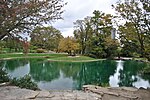Spring House Gazebo

The Spring House Gazebo is a historic gazebo of Eden Park within Cincinnati, Ohio, in the United States. Designed by architect Cornelius M. Foster and completed in 1904, it is the oldest enduring park structure in the Cincinnati municipal park system. As an icon of the entire park system, it appears in the logo of the Cincinnati Park Board. The gazebo was constructed in the Moorish style, with brightly painted arches and ball finials.The gazebo took its name from the old spring house it replaced. Said to have therapeutic qualities, locals hauled away the spring water by the bucketful until the spring was found to be contaminated. The well was sealed off in 1912.The Spring House Gazebo stands near the center of the park next to Mirror Lake, a large reflecting pool and former city reservoir with a walkway around its perimeter. The seasonal fountain in Mirror Lake shoots water 60 feet (18 m) in the air and can be seen from miles away from the hilltop park.
Excerpt from the Wikipedia article Spring House Gazebo (License: CC BY-SA 3.0, Authors, Images).Spring House Gazebo
Eden Park Drive, Cincinnati Walnut Hills
Geographical coordinates (GPS) Address Nearby Places Show on map
Geographical coordinates (GPS)
| Latitude | Longitude |
|---|---|
| N 39.11425 ° | E -84.49351 ° |
Address
Mirror Lake
Eden Park Drive
45206 Cincinnati, Walnut Hills
Ohio, United States
Open on Google Maps









